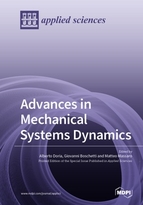Advances in Mechanical Systems Dynamics
A special issue of Applied Sciences (ISSN 2076-3417). This special issue belongs to the section "Mechanical Engineering".
Deadline for manuscript submissions: closed (30 October 2019) | Viewed by 50186
Special Issue Editors
Interests: mechanical vibrations and identification; energy harvesting; robot vibrations; multiphysics systems
Special Issues, Collections and Topics in MDPI journals
Interests: industrial and collaborative robotics; robot and mechanism design; performance evaluation; cable-driven robots
Special Issues, Collections and Topics in MDPI journals
Interests: vehicle dynamics; multibody dynamics; optimal control; road vehicles; mechanical vibrations
Special Issues, Collections and Topics in MDPI journals
Special Issue Information
Nowadays, mechanical systems are increasingly integrated with electronic, electrical, and fluidic systems. This trend is present not only in the industrial environment, which will be characterized soon by the cyber-physical systems of industry 4.0, but also in other environments like automotive technology, rehabilitation and bio-engineering, smart materials and domotics. In this context, purely mechanical systems with quasi-static behavior will become less common and the state-of-the-art will be represented soon by integrated mechanical systems, which need accurate dynamic models to predict their behavior. Therefore, mechanical systems dynamics is going to play an increasingly central role. Significant research efforts are needed to improve the identification of the mechanical properties of the systems, to develop models taking into account non-linearity and to develop efficient simulation tools. This Special Issue aims at disseminating the latest research achievements, findings, and ideas in mechanical systems dynamics, with particular emphasis on applications that are strongly integrated with other systems and require a multi-physical approach.
Papers are welcome on topics that are related to the theory, practice, and applications of mechanical systems dynamics, including but not limited to the following:
- The identification and dynamics of multi-body systems;
- The dynamics of automatic machinery;
- Dynamics stability and control of vehicles;
- The dynamics of connected and autonomous vehicles;
- The dynamics and control of robots;
- Innovative robots;
- Medical robotics (surgery, rehabilitation);
- The dynamics of multi-physics systems for energy harvesting.
Prof. Dr. Alberto Doria
Prof. Giovanni Boschetti
Prof. Matteo Massaro
Guest Editors
Manuscript Submission Information
Manuscripts should be submitted online at www.mdpi.com by registering and logging in to this website. Once you are registered, click here to go to the submission form. Manuscripts can be submitted until the deadline. All submissions that pass pre-check are peer-reviewed. Accepted papers will be published continuously in the journal (as soon as accepted) and will be listed together on the special issue website. Research articles, review articles as well as short communications are invited. For planned papers, a title and short abstract (about 100 words) can be sent to the Editorial Office for announcement on this website.
Submitted manuscripts should not have been published previously, nor be under consideration for publication elsewhere (except conference proceedings papers). All manuscripts are thoroughly refereed through a single-blind peer-review process. A guide for authors and other relevant information for submission of manuscripts is available on the Instructions for Authors page. Applied Sciences is an international peer-reviewed open access semimonthly journal published by MDPI.
Please visit the Instructions for Authors page before submitting a manuscript. The Article Processing Charge (APC) for publication in this open access journal is 2400 CHF (Swiss Francs). Submitted papers should be well formatted and use good English. Authors may use MDPI's English editing service prior to publication or during author revisions.
Keywords
- dynamics
- multi-physics systems
- vehicle dynamics
- robot
- multi-body








